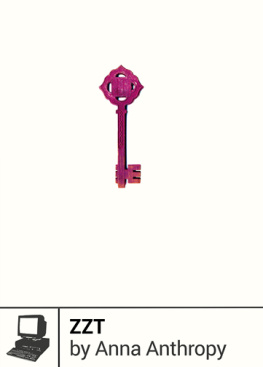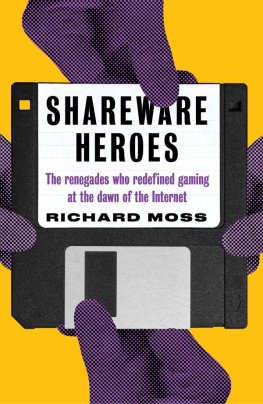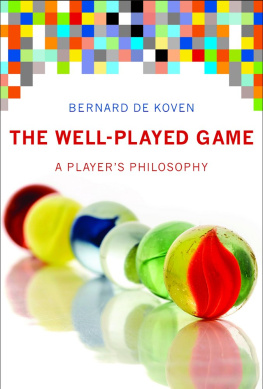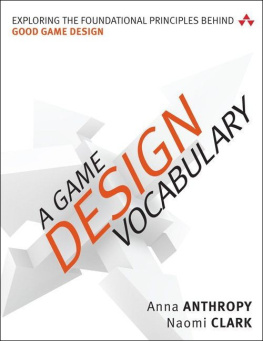ZZT
Anna Anthropy
APPENDIX B: RECOMMENDED READING LIST
Here are some ZZT games that I didnt find a place to talk about in the rest of the book. Most if not all of these can be found at .
Acecaves by Prakash Padole is a simple but sincere adventure that sprawls in many different directions, inventingdepending on which path you taketombs, villages, demons, magic earrings, a trip to hell, and discarding them as quickly as theyre conjured in a way that reminds me of the creativity and genius of an eight-year-old storyteller.
Al Paynes Smiley Guy (one of the ZZTs Revenge winners) is a charmingly twee game about the efforts of the titular hero (a regular every day kind of fella whos bff with Rambo) to explore a whimsically gruesome settingthe body of a supervillains Living Laboratory. Also see the games neat sequel, Toxic Terminator .
Oaktown by Shaun Taylor and Brian Keeler (aka Pacific Systems) is a game that is clearly the work of two friends, and follows the efforts of Shaun to save the town from Brian (who has gone rogue). I like the scale of the town, which is busy and colorful in a Richard Scarry kind of way. There are a lot of dense ASCII tableaus that are incredibly pleasing to me.
Mentioned earlier in the book, Wuzzle (listed as CJ Wuzzle on z2) by Catherine Fatrat Ryan is a little space opera populated with invented-on-the-spot lore and jokes about toilet paper. Unlike the above games, which are more action-oriented, Wuzzle is focused mostly on exploring and interacting with a tiny neighborhood of alien weirdoes. And unlike most funny ZZT games, the humor tilts more toward young adult novel than mean.
Barjesses Nightmare is also a mostly nonviolent game, a collection of logic puzzles, riddles, some neat mazes, and some of those Boulder/Slider puzzles so common in ZZT games. Also of interest is the authors ZZT Syndromes , a study of common author mistakes in ZZT game design, presented in a scared straight sort of format: The player is invited to confront her hubris and play through those syndromes for herself.
POP , by tucan (mentioned briefly earlier), is a puzzle game of a different sort, closer to LucasArtss absurd Secret of Monkey Island than any kind of Boulder-pushing puzzle. The player is given a command that lets her attempt to use items shes found on people and shapes in the environment as she navigates a surreal tower that recalls Kudzu but is painted in more stark and vivid splashes of color. Really gorgeous.
myth Parrishs Winter takes its cues not from something as self-consciously silly as Monkey Island but from the austerity of Myst and its relatives. A sparse and appropriately cold game, Winter , while technically ambitiouslooking less like a ZZT game than these othersnevertheless finds clever uses for many of ZZTs built-in puzzle pieces.
Flimsy Parkinss Sixteen Easy Pieces uses no scripting, but is instead an incredible work of engineering that combines ZZTs many stock elements into intricate and dense puzzle set pieces. You look at a Board and it looks like a mad grid of shapes, but then you look closer and it becomes playable. Also: Flimsy Parkinss hack/perversion of Town of ZZT (listed on zzt.org as Flimsys Town of ZZT ) replaced the original Town in z2s ZZT.ZIP download for a while, and is at times almost terrifying.
#end
Acknowledgements
Thanks to the following ZZT authors for participating in interviews about their experiences with ZZT. Even those who werent quoted in the text contributed to my understanding of ZZT and its history: Ben Abraham, Ross Andrews, Paige Ashlynn, Rob Clarke, clysm, Core Xii, draco, Dr. Dos, Julian Fleetwood, James Grimmelmann, Zack Hiwiller, Alexis Janson, Jun Sebastin Robles Jimenez, Jeffrey Jones, Chris Jong, Jeff Kirchoff, KKairos, Casey Kolderup, LSK, Jeremy Penner, Rob_P, Adam J. Piskel, John D. Moore, Tim Morales, Chris Mounce, Jason Moses, Michael Kayin OReilly, Jason Rice, Jeanne Thornton, Jude Tulli, Trish Sanders, Justin Smith.
Thanks to those who volunteered their time to help copyedit the book: Jeanne Thornton, Ryan Plummer, and James Jacobo-Mandryk.
And thanks to my partners, who read my manuscript and patiently listened to my insecurities about it, and were able to convince me Id written something good nevertheless.
Special Thanks
For making this series possible, Boss Fight Books would like to thank Andrew Thivyanathan, Carolyn Kazemi, Cathy Durham, Ken Durham, Maxwell Neely-Cohen, Jack Brounstein, Andres Chirino, Adam J. Tarantino, Ronald Irwin, Rachel Mei, Raoul Fesquet, Gaelan Dcosta, Nicolas-Loic Fortin, Tore Simonsen, Anthony McDonald, Ricky Steelman, Daniel Joseph Lisi, Ann Loyd, Warren G. Hanes, Ethan Storeng, Tristan Powell, and Joe Murray. Wed also like to thank the good people at The Quarters, an arcade and bar in Hadley, MA. You can check out The Quarters at hadleyquarters.com.
Also from Boss Fight Books
EarthBound by Ken Baumann
- At last, EarthBound gets the paperback it deserves. - Kill Screen
- 10/10 Excellent. Nerdlife
Chrono Trigger by Michael P. Williams
- If writing about video games had always been this good, wed be having very difficult discussions about the medium right now. Nintendo Life
Coming Soon from Boss Fight Books
Galaga by Michael Kimball
Super Mario Bros. 2 by Jon Irwin
Jagged Alliance 2 by Darius Kazemi
Boss Fight Books
Los Angeles, CA
Copyright 2014 Anna Anthropy
All rights reserved.
ISBN 13: 978-1-940535-02-9
First Printing: 2014
Series Editor: Gabe Durham
Book Design by Ken Baumann
Page Design by Adam Robinson
FOR THE CHILDREN OF THE GLOW
:touch
1: PURPLE KEYS
I must have been nine or ten.
There was a flea market at my schoolthe cavernous gymnasium packed with vendors, tables, booths. The man tending the software booth was old, white, and white-haired. He probably was not humming the lyrics to Led Zeppelins Stairway to Heaven, but since I dont remember, lets agree that the possibility exists, for the sake of thematic connection.
His display bristled with little plastic packages, squat rectangular envelopes, shiny as beetle wings. Beneath the plastic, each held a card with a single still image of some weird pixel elseworld, along with a bunch of text for which I had no contextthe name of the game and its publisher, none of them recognizable.
Having already encountered Ms. Pac-Man, Missile Command, Asteroids, and Super Mario Bros. , I recognized these curiosities before me as games: They had that blocky abstraction that suggested they werent merely images but icons, characters in some arcane, magical language.
So they were games. For the computer? My parents had bought a computer recently, a desktop with Windows 3.1 installed. I was awful at the one game Id found on it that wasnt a card game, the one where a mouse tries to trap cats by pushing blocks around. If you gave a cat a single opening, you were fucked.
I had the vague sense that the computer spoke the same language as the games I had played on my dads Atari and Nintendo (later my Nintendo), that if I pressed the right button I could make it speak to me too. But I never found the button.
I went home with the plastic package that leapt out as the most colorful: concentric rings of polka-dotted greens and blues, lines of bright crimson on purple, a plump white smiley face beaming from the center. The label said, Super ZZT, Potomac Computer Systems.
This was actually, I would learn much later, a mislabeling: Super ZZT was a spin-off, a sequel, and the picture on the card was of Monster Zoo , one of the three Super ZZT games. What was in the package was not Super ZZT, nor was it Monster Zoo .
What was in the package was a 3.5-inch floppy disk, a flat, square thing, much thinner and more easily broken than the fat Atari cartridge Missile Command came on. I took it home and put it in my computer. I probably negotiated a lot of confusion about running the program, installing, booting into DOS, and pointing DOS to C:\ZZT.
Next page





![Ethan Ham [Ethan Ham] - Tabletop Game Design for Video Game Designers](/uploads/posts/book/119417/thumbs/ethan-ham-ethan-ham-tabletop-game-design-for.jpg)
